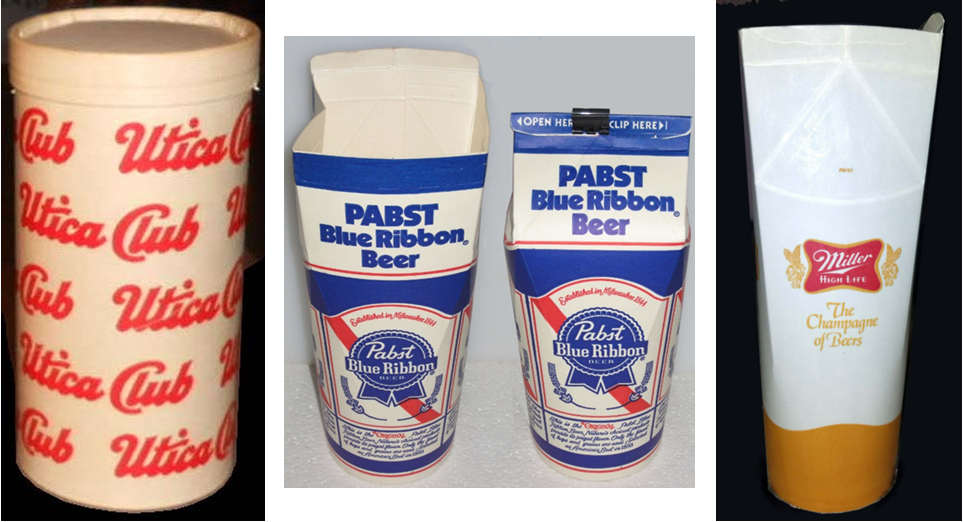Rushing the Growler to Ruth
Evelyn and Howard Smith welcomed twin girls, Lorraine and Roberta, into the world on November 14, 1949, at Mount Vernon Hospital in Mount Vernon, New York. One day later, Ruth Kain gave birth to her son, Michael, four years to the day after the birth of her first son.
Over subsequent years, the Smith family would recall how Ruth requested and received beer shortly after giving birth. It was brought to her in a takeout container from a nearby bar. Some might say it was too soon for a drink, but certainly any new mother is entitled to a cold one.
Later, Michael’s older brother, Vincent, would marry Lorraine and Roberta’s cousin, Patricia (the marriage resulted in the birth of three boys, including one beer blogger). Eventually, the familial connection to the Mount Vernon Hospital maternity ward was made. While the story is cute, what most grabbed my attention was the takeout container.
Of course, most of us are familiar with growlers. And sure, they’ve come in varying forms and materials. But the growler from the late 40s that was described to me is something akin to a cardboard take-out soup container. I had never heard of this before.
A little online sleuthing brought me to the always rewarding JK's Miscellaneous Beer Pages. In particular, this page. Sure enough, there was a period where this type of vessel was used in the US for to-go beer.
A Little Background
The use of growlers in the US seems to have been particularly popular beginning in the 1890s. There are varying stories that explain why the term “growler” is used, and I’m not going to get into that here. However, over the years “growler” has generally referred to a container of varying composition used to take draft beer off-site from a commercial establishment.
In the late 1800s/early 1900s, a growler was often just a pail. It was not uncommon to see people carrying these pails from a bar to private residences or places of work. The saying “rushing the growler” was used to describe this activity, and the people who did it were often referred to as “bucket boys” (“Kesseljunges” to German immigrants).
The Temperance Movement and Growlers
As the Temperance movement was on the rise, growlers became a target, especially as children often rushed the growler for their parents and other adults. Rhetoric like the following from the Michigan Campaign Manual for a Dry State was not uncommon:
“Little children without clothes, without food and without fire cannot compel a maudlin father to stop exchanging his dimes for growlers of beer. But isn’t a great, strong city, founded by a man who wouldn’t cheat an Indian, powerful enough to stop this growler traffic?”
Due to this growing movement, a 1913 edition of the National Bulletin notes the need to find creative ways to dodge the societal resistance to rushing the growler:
“In the old days an ordinary tin pail was the vessel mostly used, and nobody had any qualms of conscience in returning with it filled to overflowing with foaming “suds.” But those days are no more. To rush a “growler” nowadays means that you will be socially ostracized in your neighborhood. There are a dozen and one ways of disguising the “growler.” Among the most popular is “Fanny.” This is a curved receptacle, about eight inches long and three wide, so designed to fit under your coat and not bulge too much…With a “Fanny” under your coat one might meet the clergyman or hold conversation with Mrs. White Ribboner, and neither would imagine that you were taking home a pint.” (note: white ribbons are a symbol of the Woman's Christian Temperance Union.)
Ruth’s Growler
Returning to the vessel used for my grandmother, its origins go back to the pre-prohibition era. A company called Sealright was noted in a 1964 New York Times article for making paper containers for draft beer at least as far back as 1917. The article noted how this product modernized rushing the growler.
The Sealright containers were cylindrical, paper products that had varying coatings over time. Coatings included wax and plastic.
Sealright didn’t make this product solely for beer, and once prohibition hit, they advertised widely for a variety of other products like ice cream, cottage cheese, and even oysters. As they said, it was “a safe clean way to carry moist foods”.
Though some states were reluctant to allow growlers after Prohibition, their use did spring up again. As shown on the Jess Kidden page, breweries like Pabst, Miller, and Utica Club made use of them. These containers morphed into the shape many now associate with milk cartons. They are still used for beer in Africa where some umqombothi producers use them.
Umqombothi cartons from an article in Taste.
With the ubiquity of packaged beer, growlers began to fade in the 1950s. The tradition was revived later in the century by small craft brewers. Particularly for those that didn’t have the means to produce packaged beer for customers.
My grandmother was a strait-laced, pious Irish-American Catholic. The fact that she was drinking beer in the hospital right after having a baby is a bit surprising for me. But as my dad says, “she liked her beer.” According to him, the beer she drank in the hospital was likely Rheingold or Ballantine.
My grandmother and father, Ruth and Vincent Kain (and I think my other grandparents in the background.)
The growler, in all its varying formats, doesn’t seem to be as popular as it once was in the craft beer community. However, technology has come a long way, and the quality of the beer served from one can be excellent. I doubt they will ever permanently go away as there are always going to be people who want to take the special draft-only release home, or just like to bring a little bit of the bar experience somewhere else. Like a hospital.





